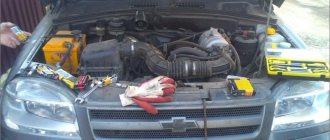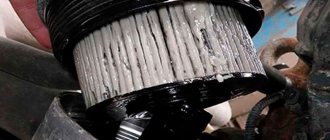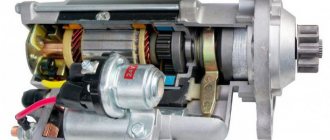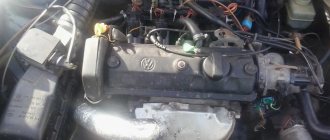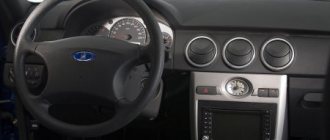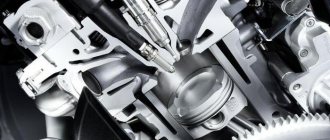Every car owner sooner or later encounters various car troubles, and Lada Priora owners are no exception. Various problems occur, including when it is difficult to start when cold. There are many reasons for such problems when starting a car is difficult. In this material we will analyze in detail the reasons when a car does not start, as well as when it troits and stalls when cold.
Main reasons
It is very difficult to immediately find out why the engine refuses to start when it is cold. There can be two options here - either there is no spark, or there is no fuel. But if you look deeper, you can identify other problems. Let's look at the most basic reasons for cold starting of the Lada Priora engine.
Experts identify the following problems. These are low quality fuel, clogged injectors, clogged fine fuel filter, malfunction of the fuel pump, incorrect pressure adjustment in the fuel rail, clogged air filter, dirty throttle valve, clogged idle valve and low ambient temperatures during engine starting. Also, the Priora has difficulty starting when cold due to faults with the mass air flow sensor and temperature sensor.
Low quality fuel
At domestic gas stations, low-quality fuel is by no means uncommon. But even at branded gas stations you can buy low quality gasoline. As a result, the car will be difficult to start. The car will leave the gas station on the remaining old gasoline, and the engine will be warmed up. But after being idle, it will be quite difficult to start the car. There are several types of low-quality gasoline.
Fuel may be dirty: it may contain various deposits. They clog the fuel channels as well as the filters. As a result, the pressure in the fuel rail will be insufficient, and it will be very difficult to start the engine.
Gasoline can also be low octane. Most often, with such fuel, the car may not start when cold even the third time. You will hear the noise the engine is making, you will feel weak thrust, and detonation will occur. Experts do not recommend starting a car on this fuel.
To eliminate the cause, it is enough to drain the bad fuel and then flush the fuel system. Then you need to fill the tank with good gasoline.
Fuel pump
This is one of the popular reasons why Priora has difficulty starting when cold. This is due to a malfunction in the fuel pump. You can even hear the sound of the node operating. But if the pump is faulty, the fuel system will not have the pressure necessary for normal operation. There is no pressure in the fuel rail, which means that starting will be poor, or the engine will not start at all.
The fuel pump can only be checked using your ears. You need to turn on the ignition of the Lada Priora. At the same time, if the fuel pump is working, a characteristic buzzing sound will be heard from the side of the tank. It will only last a few seconds. When a sufficient amount of gasoline is pumped into the ramp and the pressure becomes normal, then the pump will turn off. If there is no buzzing sound after turning on the ignition, it is recommended to replace the fuel pump.
A worn-out engine causes poor car starting
This phenomenon is very rare. In general, Priora power units are quite durable when used properly. Engine wear can be determined by high oil consumption and dark exhaust from the corresponding pipe.
A competent motor mechanic can help you figure this out and also measure the compression.
Poor engine starting due to the crankshaft position sensor
This sensor is a device that sends a signal to start, and when it fails, the car will not start at all. But even here there are some nuances. It happens that dirt accumulates on the sensor, it can also accumulate on the damper, and then starting will not occur the first time. You can check this yourself. The device is located on the oil pump housing on the left side of the toothed pulley. If the engine does not start well, visually inspect the device; if there really is dirt there, then it needs to be removed.
Electric power steering Priora
Priora fog lights
Throttle valve
A dirty throttle body could very well be the cause. The Priora has difficulty starting when cold due to the supply of not clean air through the damper, but with various deposits. All this can prevent the preparation of a normal mixture in the correct proportions.
Sometimes the throttle valve can even get stuck due to the huge amount of deposits on it. To solve the problem, experts recommend cleaning the throttle - you can do this yourself using an injector cleaning spray.
Ignition system
This is another fairly common option and the reason why the Priora has difficulty starting when cold. Almost regularly, due to sudden and constant temperature changes, various microcracks form in the ignition coils. When the coil heats up, it tends to expand. If there are cracks between the walls of the coil, then there is no hot breakdown, since the gap in the crack will be minimal. When it is cold, the microcrack will be larger and as a result there will be a breakdown. There will be no spark on the spark plug. There is no ignition of the mixture, the car does not start well.
The problem exists not only with the ignition coils, but with any other components that operate in the Priora ignition system. This could be a distributor, wires, spark plugs. In this case, there is nothing better than replacing the coil and other elements.
Low battery charge
If the Priora has an old battery installed, then in cold weather it discharges faster. This means that starting a cold engine in the morning can be problematic. Sometimes even a new battery drains quickly. In this case, you should look for current leaks. It may be in the wiring or the leak is occurring in some device.
If the search for current leakage does not produce results, then it is recommended to check how the generator charges the battery. If the charge is insufficient, then the battery will not charge fully. As a result, the starter will turn much harder than if the engine was cold.
Idle speed sensor
This is also a common problem when the Priora 16 valves have difficulty starting when cold. This sensor is an electromagnet and a rod. When the car is cold, the temperature sensor reports this to the control unit and it sends a signal to the sensor responsible for idling. The engine speed will be increased until it warms up. The sensor rod extends and the throttle opens slightly. When the engine warms up, the ECU reports this to the sensor. The rod slowly moves back.
If there is a malfunction with the idle speed sensor, the rod does not extend, and accordingly, the throttle does not open slightly or does not open completely. The sensor may be dirty, or the coil located inside the IAC may fail.
Computer diagnostics in identifying the cause of a poorly starting engine
It is impossible to fully check the Lada Priora in order to identify the reasons why it starts poorly when cold or even when hot without specialized equipment and qualified specialists. Nevertheless, we will tell you several useful positions that you can check yourself.
The easiest way is to check the performance of the car's cylinders. For this purpose, remove the engine protection, start it, leave it idling. When the engine has been running for a while, you need to remove the connectors from the ignition modules one by one.
In this case, you need to be more careful and have fairly good hearing. It is necessary to accurately determine, when switching off, which of the available cylinders changes the operating mode the least. Once you have been able to identify the cylinder, you need to do the following simple work:
- Using a “10” wrench, unscrew the mounting bolts of the modules from the faulty cylinder and any other cylinder.
- Replace and secure the cylinders as required.
- Repeat the work with switching on and auditory detection; if the signs of poor starting of the unit move to another cylinder, then the problem clearly lies in the ignition module.
- If you do not see a change, then change the spark plugs yourself.
- Repeat the procedure again. We found that there are no changes, which means the cylinder is worn out or there is a problem in the injector.
Let’s not forget about the main sensor responsible for starting the LADA Priora engine – the mass air flow sensor. It is the sensor indicated above that reads the fuel into the cylinders, after which, based on the data from this very sensor, the fuel supply is dosed by the control unit. This always happens because the sensor we designated shows that more air is flowing, but in reality the indicators are not critical.
A competent diagnostician and his specialized equipment will help you easily find the cause of the malfunction. However, some experienced owners of LADA Priora can easily identify malfunctions in the sensor on their own; for this purpose, you need to remove the connector during actual work. Depending on the type of control unit, the speed will immediately drop and the car being diagnosed will stall, or it will rise to 1500 rpm.
In addition to everything indicated, a poor start of the power plant can be influenced by the actuator abbreviated as IAC (stands for idle speed control), an auto device such as TPS. In this case, only computer diagnostics will come to the rescue.
Compression
If the 16-valve Priora has difficulty starting when cold, and all the options described above are not suitable, then it is worth checking the compression. In this case, with low compression, starting a cold engine can be very difficult.
When engine parts are warm enough, they expand. Even a slight expansion will be enough for the compression to rise and the engine to start. If the engine is cold, there is no expansion. Therefore, starting will be difficult.
Determining the circumstances of a “bad” engine start
Every more or less experienced driver of this type of malfunction, when the engine does not start, gives an initial assessment, finding out under what circumstances the Lada Priora does not start. So, there are 3 circumstances when the launch is poor.
- It is impossible to start the engine when it is hot.
- Doesn't start well when cold.
- The engine does not start well in any condition.
Each of the above circumstances has its own nuances and reasons, but they are all united by one single symptom - the car does not start well.
In the first case, Priora does not start immediately, as expected, but after a series of full turns of the crankshaft by the starter, then if when the power unit has already reached a temperature exceeding the 90-degree mark, in other words, when the engine is warmed up, and a bad start occurs after mileage
If the car stalls and stalls when cold, as option 2 tells us, it happens when the car doesn’t start well with a cooled engine, it’s probably the first start in the morning, or the car has been standing for a long time; this also happens in harsh winters.
3rd option, when your Lada Priora refuses to start the first time in any conditions. It doesn't matter whether the engine is cold or hot. We invite you to further consider some of the possibilities that every car owner has in order to solve this problem with his own hands.
If you need to purchase rims in Ukraine, then on the website https://nakolesah.net.ua/diski/ you will find a huge range of rims for every taste and budget, and competent consultants will also help you with your choice.
Oil
Many car owners try to change their oil before winter. But not everyone knows that the oil with the lowest viscosity is best suited for winter. Thick oil will simply harden in winter. In addition, when the engine is cold, it is very difficult for it to drive thick oil through the channels. If the picture is complemented by an old battery, then this aggravates the situation even more. Therefore, you need to try to purchase oil of exactly the viscosity at which the engine can start normally even in cold weather. Typically, a product with a viscosity of 5W30 is purchased. But in any case, you need to look at the manufacturer's recommendations. You should not deviate significantly from the tolerances.
Starts and stalls
It also happens that the Priora has difficulty starting when cold and stalls. First of all, experts attribute this to the fact that little fuel is supplied to the combustion chambers, and with it cold air, which interferes with the normal ignition of the fuel mixture.
This problem can be fixed. To do this, you need to insert the ignition key into the lock to start the fuel pump. The ignition is turned off and then turned again to start the pump. When the pump is turned off, you can proceed to start the car.
The second solution to this problem is to check and try to stabilize the pressure in the fuel system. They also check the fuel filter and adjust the throttle clearance. Next, check the spark plugs and wires.
Lada Priora does not start when cold
The most common thing in the situation we are considering is when the car has difficulty starting when cold. In such a situation, where to start checking and searching for the causes of malfunctions, when when cold it troits and stalls? I would like to immediately note that most of the reasons are exactly the same as if the car does not start well when hot. Only in this embodiment, a malfunction in the electronic part is more common. Simply put, the LADA Priora's so-called actuators or a number of special sensors are malfunctioning. Separately, we should talk about the refusal to start the engine in severe frosts. Moreover, cars with distributed fuel injection work much better than carburetor cars during frosts. And everything will indicate wear and tear on the power unit if your car has trouble starting in any weather.
Lifehack: Priora has trouble starting hot or cold - reasons
Engine problems can appear suddenly. The same “check” that is displayed on the dashboard at the most inconvenient moment forces a person to immediately schedule the nearest diagnostics and repairs.
Find out from the article why the Priora starts and stalls - there are three reasons for this, the first is, of course, the fuel pump. Fuel delivery problems can be scary when you try to start the car, but everything is fine. There is also a problem with the fuel system, or rather with its regulator, when the Priora is just as difficult to start when hot, although there is also a sensor involved. In general, in this article I have collected for you the main breakdowns why the car will not start - let's go!
Lada Priora does not start when hot
The car has driven a certain distance, after which it stops and the car does not start the first time. What could have caused this? And there are a lot of reasons for this situation. Experts divide them into several groups:
- Breakdown/error of sensors/mechanisms in the control system.
- Fuel system malfunction.
- The power unit is worn out.
The best option would be if you check the presence of fuel in the injector frame. A common cause of this problem is a problem with the fuel supply. Open the hood and remove the decorative protective trim from the engine. In Lada Priora, between the radiator and the power unit there is a so-called intake manifold. Just below it is the fuel frame. The actual end part is equipped with a special bypass valve, which is always closed, in turn, with a plastic lid. The valve needs to be unscrewed and then pressed on the very core. At this very moment you need to be more careful, since a fairly strong release of fuel should occur.
Another method, of course, is not 100 percent reliable, but it is used. Immediately before starting, perform pumping several times; in other words, you need to wait until a device such as a fuel pump is turned off, without turning on the starter, then turn off the ignition, and turn it on again without the starter, and do this several times. Next you need to crank the engine. If overall starting has improved, then there was little pressure, and the first thing you should pay attention to is the fuel pump and filters.
Reasons why Priora starts and stalls - what to watch
It happens that the engine in the car starts, and then immediately stalls. This means that all the initial processes are started, but it is not possible to “squeeze” them in order to bring the engine to normal operation. As an example, you can hear that the starter is turning, but the Priora does not start.
The starter engages, but the Priora does not start. This is a clear sign that the starter is transmitting force to the crankshaft, and some other part is not performing its functions in the starting cycle. Therefore, when the Priora starts and stalls, several systems are checked, which begin to work before the rest, starting the engine. Priora takes a long time to start for several reasons:
- The fuel pump creates insufficient pressure in the fuel system. This happens - the starter starts to turn the crankshaft, the spark comes from the spark plugs, but they simply have nothing to light - the fuel has not yet arrived.
- The ignition coil turns are damaged. The coil received a responsible mission - to convert the current from the battery into current for the spark plug so that it would work. Again: fuel is supplied, the crankshaft moves, but there will be no ignition. It’s also worth checking the candles here - with carbon deposits, they can also give such an effect.
- The intake tract is clogged or not sealed. That is, the problem is not in the fuel pump, but in the next “stage” of fuel supply to the chamber. It is recommended to blow out the filter.
Priora won't start, starter turns
| Possible malfunction | Diagnostics | Remedies |
| There is no gasoline in the tank | On the instrument panel the fuel level indicator is at zero. | Pour gasoline |
| Battery is low | The voltage at the battery terminals without load is less than 12V. When trying to start the car, a crashing sound is heard from under the hood. | Charge the battery or replace it with a new one |
| Oxidation of battery terminals or wire terminals, their fit is not tight | When you try to start the engine, the voltage in the on-board network drops much more than at the battery terminals. In this case, a crash may be heard under the hood. | Clean the contacts, lubricate them with petroleum jelly and tighten the terminals |
| Unreliable connection of electrical circuits of engine control and power supply systems | Check the connections of the connectors and the reliability of the contacts in the blocks. | Fix faulty wire connections |
| Increased resistance to rotation of the crankshaft (scores on the shafts, bearing shells, cylinder-piston parts, deformation of the shafts, frozen engine oil, jammed generator, jammed coolant pump) | The crankshaft turns slowly. If the engine is started in severe frost, and the engine was working properly the day before, then most likely the engine oil has frozen. If you hear extraneous noise when starting the engine, check the free rotation of the pump and generator pulleys. | Use the recommended engine oil. Repair the engine. Replace the pump and generator. |
| Malfunction in the ignition system | Check for spark. | Check the circuits and devices of the ignition system. Replace faulty system elements. |
| The high voltage wires are connected in the wrong order or the wire is disconnected | Inspect. | Connect the wires in the correct order |
| The timing belt is broken or the belt teeth are cut off | Open the front timing cover and check. | Replace timing belt |
| Disturbed valve timing | Check the marks on the crankshaft and camshaft pulleys. | Set the correct shaft position |
| Malfunction of the computer (brains), its circuits, crankshaft position sensor or coolant temperature | Check the supply of +12V to the ECU, the sensor circuit, and the absence of damage to the sensors themselves. | Replace ECU, sensors. |
| The idle air regulator (IAC) or its circuits are faulty | Check the idle air control. When starting the engine, lightly press the gas pedal. If the engine starts and stalls when you release the gas pedal, the sensor is faulty. | Replace sensor |
| The fuse is blown or the main relay of the control system is faulty | Check fuse and relay. | Eliminate the cause of the blown fuse. Replace fuse and relay |
| Fuse blown, fuel pump relay. Circuit, relay or pump is faulty. | When the ignition is turned on, there is no sound of the pump running. Check the fuse. Apply voltage to the pump from the battery. | Clean contacts, replace faulty circuits, replace fuse, pump and relay. |
| The fuel filter is dirty, the water in the fuel line is frozen, the fuel line is damaged | Check the pressure in the fuel rail and the condition of the fuel lines. | Replace the filter, blow out or replace the fuel lines. |
| Insufficient pressure in the fuel rail | Check the pressure in the fuel rail, the pump strainer and the condition of the fuel lines. | Clean the filter. Replace pump, fuel pressure regulator |
| Faulty injectors or their power supply circuits | Check the injector windings with an ohmmeter. Check the chains for breaks. | Replace injectors, replace chains |
| Air leak into the intake tract | Inspect the joints and fittings of the hoses and clamps. During start-up, turn off the vacuum brake booster and plug the receiver fitting. | Eliminate air leaks, replace vacuum booster |
Why Lada Priora won't start - reasons
There are two cases when the car does not start at all - if the starter works or if it does not work. Both cases are negative, but the difference is that the signs of trouble to listen for and look for are slightly different. If the Priora starter does not turn, it is recommended to check the following points:
- The battery may be discharged. Charge it or, if you're short on time, borrow a working battery from a friend to test your guess.
- The battery terminals are oxidized or the wire terminals are oxidized. Check, ring the contacts, and then lubricate them with technical Vaseline. Finally, check the tightness of the terminals and, if necessary, tighten them.
- The engine or other components of the machine are jammed. The culprit may be the crankshaft, generator pulley or pump. We'll have to check all this.
- The starter is broken, the inside of it is damaged or worn out: the drive gear, the teeth of the flywheel ring. In order to determine the malfunction, you will have to dismantle and then disassemble it - only inspection of the parts can confirm the hypothesis. You don't always need to change the starter - just install a new part inside.
- Problems with the starter circuit. You will have to carry out diagnostics first while driving, and then look at it manually. Most often, the culprits are oxidized or loose wires, relays, or ignition switch.
- Starter traction relay malfunction. The diagnostic mechanism is no different from the previous version: turn the key to the second position, there should be clicks. The relay clicks and this is normal starter operation.
- Poor contact with the “minus”, the wires or contacts of the traction relay are oxidized. A click will be heard, but the starter will not turn. You need to ring the entire system, and then clean it at the connections, tighten the terminals.
- Short circuit or break in the holding winding of the traction relay. If this is the case, you will have to replace the starter traction relay. Instead of a click, a cracking sound will be heard when you turn the key, and the relay itself needs to be checked with an ohmmeter or touched, assessing the degree of heating.
- The problem is inside: the armature winding, the commutator, the starter brushes are worn out. You need to dismantle the starter and carry out diagnostics from the battery, and then with a multimeter. The freewheel is running slowly. The armature will rotate, but the flywheel will remain in place.
Also, the VAZ-2170 may not crank the starter - when you can’t hear anything at all when you turn the key in the ignition switch. This case is associated with the following problems:
- The gas has run out or the battery is low. It’s trivial that the starter has nowhere to get energy to start. If the battery is discharged, you will hear a cracking noise when you try to start the engine. And the fuel pump cannot pump up fuel to release it inside the chamber. On the dashboard, the fuel gauge needle will be at zero.
- Oxidation of the wires or battery terminals or connections are not just tight enough. You need to clean the contacts and then check how tightly the connections fit together.
- Mechanical damage to the crankshaft (when scuffs, cracks, chips appear on bearing shells, shafts, engine oil freezes or the generator or anti-freeze pump jams). First, you should change the engine oil and check the shafts for damage, then change the generator and pump.
- No spark is produced. A coil and spark plugs work to create a spark. It is necessary to check these elements, diagnosing their operation, and then replace the faulty parts.
- Incorrect connection of high-voltage wires. You will have to look at all the connections, correct or correct what is already installed incorrectly.
- The timing belt has broken (or worn out when the teeth on the belt have worn down). The only solution is to replace the belt.
- Error in valve timing order. Inspect the crankshaft and camshaft pulleys and then adjust their position.
- Error in the "computer". First check the electrical access to the ECU and sensors. If everything is connected correctly, you will have to replace the control unit.
- The idle speed control is unstable. This can be corrected by replacing the corresponding sensor. Check fuses and relays under the steering column.
- Fuel system contamination. Checking the filter, pump, line and outlet from the tank.
- Wear of the fuel pump and, as a result, insufficient pressure inside the system.
- The injectors are worn out. Their windings need to be tested with an ohmometer and the circuit generally checked.
- Air flow to the engine is difficult. Assess the condition of the hoses, clamps and air filter.
If the Lada Priora's starter does not turn
| Possible malfunction | Diagnostics | Remedies |
| Low battery | The voltage at the battery terminals without load is less than 12V. When trying to start the engine, a cracking noise is heard from under the hood. | Charge the battery or replace it with a new one |
| Oxidation of battery terminals or wire terminals, their fit is not tight | When you try to start the car, the voltage in the on-board network drops much more than at the battery terminals. In this case, a crash may be heard under the hood. | Clean the contacts, lubricate them with petroleum jelly and tighten the terminals |
| The engine or attachments are jammed | Check the rotation of the crankshaft, pump and generator pulley. | Repair engine, generator, pump |
| The starter is faulty, the starter drive gear or flywheel ring teeth are damaged | Remove and inspect the starter. | Repair or replace starter |
| The starter switching circuit or starter relay is faulty, the wires are damaged, or the ignition switch contacts do not close | When the key is turned to position “II”, the starter traction relay does not operate (a click is not heard under the hood). Check the +12V supply to the control contact of the traction relay. | Replace starter relay, wires, ignition switch |
| The starter traction relay is faulty, there is a short circuit or break in the retractor winding, the relay armature is stuck | When the key is turned to position “II”, the traction relay does not operate (there is no click under the hood), but + 12V is supplied to the control contact of the traction relay. Remove the relay and check its operation. | Replace the traction relay |
| Contacts or wires of the traction relay are oxidized, poor ground contact | When the starter is turned on, a clicking sound is heard under the hood, but the starter armature does not rotate. Using an ohmmeter, check the resistance of the Battery-Starter circuit, as well as the ground wire. If the circuit is in good condition, remove the starter and check the operation of the traction relay by applying +12V to it from the battery | Tighten the terminals, clean the contacts, replace the traction relay |
| Open or short circuit in the holding winding of the traction relay | When you try to start the engine, you hear a crashing sound under the hood. The battery voltage is within normal limits. We check the traction relay with an ohmmeter or by its excessive heating. | Replace the traction relay |
| Burnt starter commutator, stuck brushes or severe wear Open or short circuit in the starter armature winding | The starter armature rotates slowly or does not rotate at all. Check the traction relay by applying voltage to the starter contact bolt directly from the battery | Replace starter or armature |
| Freewheel slipping | When the starter is turned on, the armature rotates, the flywheel is stationary | Replace clutch or starter |
Poor starting when cold - reasons
If the Priora doesn't start well in the morning, it's quite annoying. When the car has cooled down to too low a temperature, the reasons for the engine failure to start may be:
- Congealed engine oil or discharged battery. As a result, the crankshaft will rotate too slowly.
- The water in the ramp could freeze - then the fuel system would literally stop. Pay special attention to the gasoline you fill up with - if there is a lot of water left after it, you should change the gas station.
- The coolant temperature sensor is broken (the ECU will not be able to regulate its temperature). The oxygen sensor may also be damaged.
- Fuel injectors are depressurized.
- The cylinders have low pressure levels.
- The motor control system is faulty.
Diagnose the operation of the ignition module.
If the Priora does not start well when hot
In this case, see the second table; in addition to the reasons described, also pay attention to:
- A pressure regulator that can discharge fuel through a membrane into the receiver.
- DPKV contacts, if the sensor has been changed, check that the poles are connected correctly.
- Faulty ignition module.
Let us remind you that in some cases the Priora does not start due to a faulty immobilizer or alarm system. In some cases, reflashing the engine ECU (electronic control unit) helps solve the problem of poor starting. And regular car maintenance will help eliminate problems of poor engine starting.
Keywords: Lada Priora engine | ignition system for Lada Priora | starter Lada Priora | power supply system for Lada Priora | ECM Lada Priora
0 0 0 0 0 0
Share on social networks:
If it stalls while driving, what is it?
First of all, when the Priora suddenly stalls when the engine is running, check whether you have left the clutch pedal - perhaps you were accidentally distracted by something and did not notice how you removed your foot. But usually the car stalls when the gas pedal is released while driving. Symptoms of the problem are as follows:
- increased fuel consumption, air consumption;
- injection takes longer (the engine operating cycle is extended in time);
- The idle speed control operates with a delay;
- The voltage in the power supply fluctuates.
Source
Why does the car start only with the gas pedal?
There are two main reasons for starting an engine with gas assist - a malfunction in the ignition system and errors in the actions of the driver. Let's look at them in more detail.
Ignition system problems
The ignition does not work without the gas pedal in a number of situations:
- The car froze in the cold. Including a fuel pump that does not supply fuel to the combustion chamber when starting the engine, and only the gas pedal is able to create the required pressure in the fuel supply system.
- No spark due to dead battery. In this case, the combustible mixture is created by the fuel pump, but does not ignite, and the engine does not turn over.
- The ignition itself or the idle speed control is faulty.
- There are malfunctions in the fuel system (fuel pump failure, clogged filters).
- The mass air flow sensor is malfunctioning, causing insufficient air to enter the combustion chamber and the mixture does not ignite.
Driver errors
- In cars with a manual transmission, the engine is started with the clutch pedal depressed, which should be smoothly released when the engine picks up speed. A sudden release of the pedal stops the engine, as does a quick release of the clutch by the gas pedal.
- In cars with robotic gearboxes (automatic transmission), switching the selector when starting the engine is not necessary.
- You should always wait a short pause after turning the key in the ignition to allow the fuel pump to create the required fuel pressure in the system. When you hear the pump hum stop, depress the ignition pedal.
- If your car has a weak battery and you try to start the car in severe frost, the engine may not start because the engine oil has thickened.
- The air temperature in the system is an important parameter. Monitor the air temperature sensor - it should not show overheating or hypothermia.
In conclusion, it should be noted that if the car engine starts only with the support of the gas pedal, this does not always indicate a malfunction in the fuel supply or ignition systems. Most often, the engine needs a boost in extreme cold, when the battery is dead or the sensors are not adjusted.
If after warming up the engine, installing a new battery and adjusting the sensors, the problem does not go away, it means you are either making mistakes during ignition (untimely pressing of the pedals, haste, etc.), or you really should diagnose the fuel system and ignition components.
In a serviceable engine, throttling is safe only at low engine speeds. In winter, this is dangerous and can flood the spark plugs, overheat the engine and damage the car's exhaust system. If the simplest steps do not solve the problem, it is better to contact a service station.
- Registration
- Entrance
- To the beginning of the forum
- Forum Rules
- Old design
- FAQ
- Search
- Users
alex_niv
Electronic pedal?
How can I check this, other than replacing it with new ones?
How can I check this, other than replacing it with new ones?
Well, that would make it clear.
We take a piece of galvanized steel or fold it in half from a cut can, a total of 0.5 mm is needed, and if xx appears while warm, we look for the reason in rrx.

